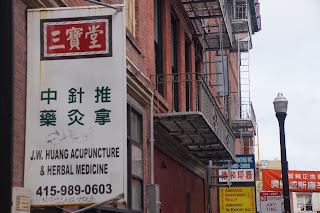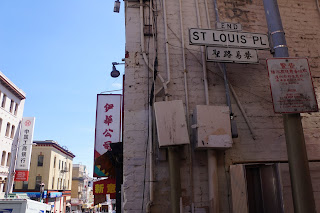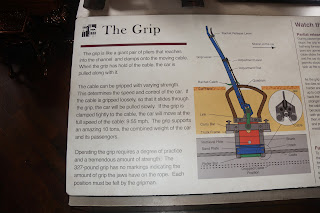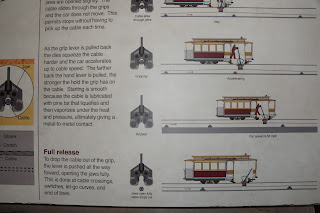MONDAY,
AUGUST 10:
Today
we hit 2 more San Francisco classics: Chinatown (done right!) and
cable cars.
Took
the ferry and caught the historic F-line street car right across from
the Ferry Terminal on rambunctious Market St. Street cars aren't the
same as cable cars . . . they both run on tracks, but streetcars, or
trolleys, are run by electrical power from overhead wires. When they
were first introduced in the late 1880's, they rapidly replaced the
existing cable cars as the preferred means of transportation in the
city, going 2-5 times faster than cable cars. But their use also
gradually waned in the second half of the 20th
century, and by 1982, they were all retired. But soon business and
community leaders mounted a campaign to bring a limited number of
them back. And so in 1995, the permanent F-line was established,
running west of the Ferry Terminal down Market, and north up to
Fishermen's Wharf.
We
transferred from our streetcar to a cable car on the California
line (our first of the day)
Here it comes!:

for a few blocks, where we got off a block or two from Chinatown. Today, we were going to experience it as it should be – with a knowledgeable tour guide. Another free tour by the same wonderful volunteer organization. Julie led us for 2 hours through colorful streets and alleys,
Here it comes!:

for a few blocks, where we got off a block or two from Chinatown. Today, we were going to experience it as it should be – with a knowledgeable tour guide. Another free tour by the same wonderful volunteer organization. Julie led us for 2 hours through colorful streets and alleys,

a
Buddhist temple
and
a paper store (when a loved one dies, on their birthday or other
commenorative occasion, family members will purchase paper images of
things the deceased would like to have with them in their next life –
everything from food and money to cell phones & hair care
products (I kid you not). Then they burn the paper, and the
resulting smoke, along with the substances it rep . Then they burn the paper, and the resulting smoke, along
with the substances it represented, ascends to the deceased.) All
the while, she presented the fascinating history and culture of the
U.S.'s first and still largest Chinatown (covers 20 blocks).
An unexpected reminder of home!
A sad part of Chinatown's early history: the alley where the Chinese female slave trade took place:
A neighborhood barber takes a break and plays his er-hu:
Here it comes:
Just room for us on the outside poles again – drat the luck! Another fun, and spectacularly scenic – ride (no pics – if you're on the outside, you dare not let go!) A quick transfer to a streetcar at Market to the Ferry Terminal, retrieved our locked bikes at the Marin terminal to ride home in the dark, and home again. On the cooler side for much of the day, especially when the wind blew – particularly against a moving cable car!
A sad part of Chinatown's early history: the alley where the Chinese female slave trade took place:
A neighborhood barber takes a break and plays his er-hu:
After
the official tour ended, the scent of baking vanilla wafting out of an alley lured
Bill and me into a small shop where they made fortune cookies. Fun
to see the process from start to finished product.
We
ate a sandwich wrap we brought with us in Portsmouth Square, the
little park on the corner of Chinatown where we entered. Juile
called this “Chinatown's living room,” because it's a gathering
place for people of the neighborhood. The neighborhood is very
densely packed, and a number of the residents here are low income –
some live in rooms that are 10x10, with no private bath nor kitchen
- and this open park affords them an area to socialize. As we ate
our lunch, we were indeed surrounded by folk playing cards, xiangzi
(Chinese chess), and just visiting with each other.
Made
our way back to the cable car,
and rode it up to Nob Hill, where we disembarked and briefly took in the elegant surroundings (an exclusive gentlemen's club, for one, where the entrance fee is $1,000,000, and annual dues thereafter run $250k. George Bush is a member).
to the Cable Car Museum and Powerhouse.
Besides containing models, photos, and atifacts related to the history of San Francisco's first public transportation system, the big draw here is an observation platform which allows you to see how the cable cars operate. You see where the cables underneath the streets enter into the powerhouse, the powerful motors which keep the cables running, the mechanism by which the cars clamp on to the cables, explanations of how the car operators perform various maneuvers,etc. I had no idea!
and rode it up to Nob Hill, where we disembarked and briefly took in the elegant surroundings (an exclusive gentlemen's club, for one, where the entrance fee is $1,000,000, and annual dues thereafter run $250k. George Bush is a member).
Then
walked 3 or 4 blocks down (literally!)
to the Cable Car Museum and Powerhouse.
Besides containing models, photos, and atifacts related to the history of San Francisco's first public transportation system, the big draw here is an observation platform which allows you to see how the cable cars operate. You see where the cables underneath the streets enter into the powerhouse, the powerful motors which keep the cables running, the mechanism by which the cars clamp on to the cables, explanations of how the car operators perform various maneuvers,etc. I had no idea!
The
cable car was invented here in San Francisco in 1873 by a local
resident. Until then, all city transport was of course done by horse
& wagon. It may have worked fine in lots of other cities, but
with San Francisco's hills and damp weather, when the roads got
muddy, the horses had a terrible time getting up and down them,
causing lots of accidents and even horse fatalities. So this man,
who was familiar with the uses of steel cables, came up with the idea
of attaching a car to a moving cable. It worked beyond his
expectations! Similar to the story of the streetcars, their heyday
was long gone by mid-20th
century, and the mayor wanted to get rid of them. Public opinion
from the world over, however, forced him to reconsider . . . they
were outraged at the idea of a San Francisco without her iconic cable
cars!
So
then hopped on the Powell-Hyde
car, probably the most popular route, as it climbs up Russian Hill
and makes a stop at crooked Lombard Street. We didn't get off there
today – saved that for another trip. This afternoon we just wanted
to experience the complete ride up down to the Wharf. The car was
filled to capacity on the inside, so we rode on the outside, hanging
on for dear life, marvelling at how the car with no power of its own,
only clamped on to those underground cables moving a consstant 9.5
miles/hour, climbed and descended impossible hills, with impossible
views. It was exhilarating!
Briefly
strolled around this western end of Fisherman's Wharf, ducking into a
National Park's Visitor Center to view a couple of neat films on the
maritime flavor and history of the city. Then chose a restaurant
for dinner. Shared a delicious bowl of cioppino (fish stew). Then
walked on over to Ghiradelli Square to get dessert – where else? A
classic hot fudge sundae at Ghiradelli's.
Had
planned to take the Powell-Hyde
car back to Market. But there was a long, long line for it – as
bad, or worse, than for a Disneyland ride. So we walked the few
blocks east to catch the Powell-Mason,
which
we correctly guessed wouldn't have as long a line.
Here it comes:
We
did have to wait, but less than 30 minutes.
And while we were waiting, we were entertained by watching a couple
of cars being turned around to face the other direction, since this
was the end of the line.
.



























No comments:
Post a Comment